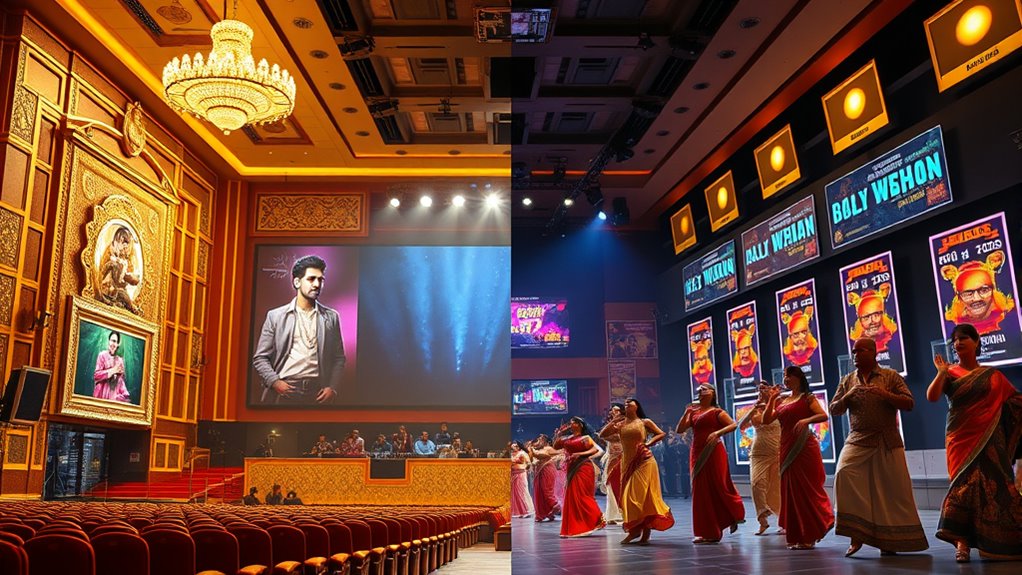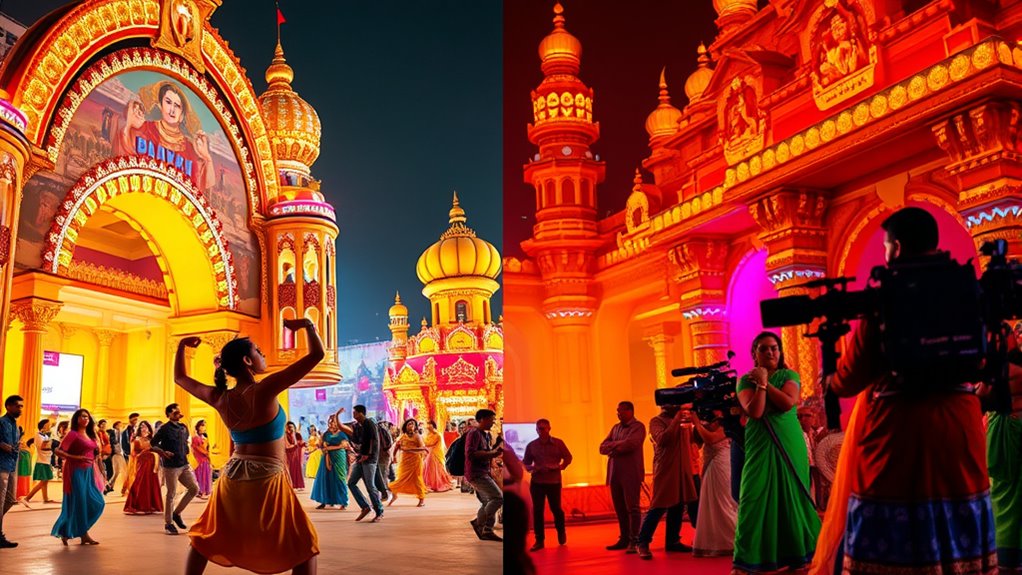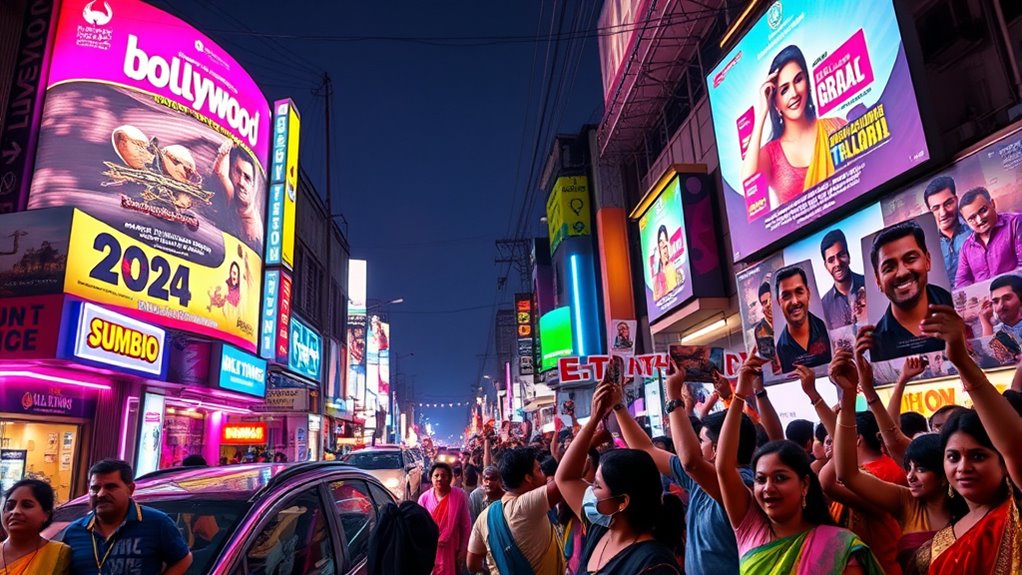In 2024, South Indian cinema outperformed Bollywood, capturing a larger share of the box office with films like “Pushpa 2” earning over ₹1,400 crore and regional industries making significant progress. Hindi films faced challenges, with collections dropping and fewer blockbusters crossing ₹500 crore. The rise of dubbed and Pan-India movies fueled South Indian success, highlighting a shifting industry landscape. Keep exploring to discover how regional cinema continues reshaping India’s film scene.
Key Takeaways
- South Indian films grossed ₹5,646 crore, surpassing Bollywood’s ₹4,679 crore, dominating the overall box office in 2024.
- “Pushpa 2,” a South Indian blockbuster, led with ₹1,403 crore, highlighting regional film strength.
- Bollywood’s market share shrank to 40%, with fewer Hindi films crossing ₹500 crore in 2024.
- Regional cinemas, especially Malayalam and Gujarati, made significant growth through innovative storytelling and dubbed content.
- Overall, South Indian cinema was the industry’s top performer, overshadowing Bollywood’s box office achievements in 2024.
Overall Box Office Performance in 2024

Despite a slight decline in footfalls, 2024 remains a strong year for Indian cinema, with total theatrical revenue reaching ₹11,833 crore. This makes it the second-best year ever, just behind 2023. You recorded 88.3 crore (883 million) footfalls, which is a 6% drop from last year. Meanwhile, the average ticket price increased modestly to ₹134, a 3% rise, helping boost revenue despite fewer viewers. Several films performed exceptionally well, with “Pushpa 2: The Rule” leading at ₹1,403 crore. Dubbing and regional releases played a crucial role, especially South Indian films. Bollywood saw notable releases but none surpassed ₹500 crore in their original versions. Overall, 2024 showcases a resilient industry adapting to changing viewer preferences and market dynamics. Additionally, the increased focus on regional and dubbed content highlights the importance of content diversification in maintaining industry growth. The prominence of regional markets like South India underscores the shifting landscape of Indian cinema.
Dominance of South Indian Films

South Indian films have markedly strengthened their hold on the Indian box office in 2024, outpacing many Bollywood releases in both revenue and popularity. They collected INR 5,646 crores this year, with Telugu and Tamil cinema maintaining strong market shares. The blockbuster *Pushpa 2: The Rule* earned INR 1,403 crores, becoming the highest-grossing film, while its Hindi-dubbed version set a new record. These films are celebrated for diverse storytelling, high production quality, and cultural authenticity, appealing to broad audiences. Plus, the crossover success of dubbed versions has expanded their reach. Their films frequently feature innovative storytelling techniques and cutting-edge visual effects, which contribute to their global appeal and critical acclaim. This technological edge has played a significant role in elevating their visual appeal and audience engagement.
South Indian cinema’s 2024 dominance: record-breaking films, diverse stories, and expanding global reach.
- *Pushpa 2* leads with INR 1,403 crores
- Diverse genres attract varied audiences
- Hindi-dubbed films break records
- Increased revenue reflects industry strength
Decline of Hindi Cinema

The decline of Hindi cinema in 2024 is evident through its decreasing box office collections and shrinking market share. Total revenue dropped from ₹5,380 crore in 2023 to ₹4,679 crore, with a market share shrinking by 4 percentage points to 40%. The decline was driven partly by increased competition from regional films, especially dubbed South Indian movies, which accounted for 31% of collections. Audience footfalls fell by 16%, from 27.5 crore to 23 crore, highlighting waning interest. Only three Hindi films crossed the ₹500 crore mark, reflecting a tough year for big releases. Limited film schedules and overcrowded weeks further impacted performance. This trend points to changing viewer preferences, content quality issues, and the need for industry adaptation to revive Hindi cinema’s relevance. The number of original Hindi films grossing over ₹100 crore also decreased significantly, indicating challenges in producing blockbuster Hindi hits. Additionally, the industry faces AI-driven challenges in forecasting trends and understanding audience preferences, which could influence future content strategies. Furthermore, the competition from regional films has shifted audience attention away from traditional Hindi cinema. The industry’s reliance on traditional storytelling methods may no longer suffice in the evolving media landscape, requiring a strategic overhaul to regain viewer interest. Moreover, harnessing emerging technologies could be crucial for revitalizing Hindi cinema’s appeal and staying competitive in a rapidly changing entertainment environment. Recognizing the importance of adaptability in content creation will be key for future success.
Notable Regional Cinema Achievements

You’ll notice that regional cinemas are making significant strides this year, with Malayalam, Gujarati, and Bengali films leading the charge. These industries are boosting their audiences and box office numbers through innovative storytelling and strategic releases. As a result, they’re reshaping India’s cinematic landscape and capturing more attention than ever before.
Malayalam Cinema’s Rise
- Malayalam films now enjoy pan-Indian popularity, with their unique storytelling styles capturing diverse audiences.
- Several movies achieved blockbuster status nationwide, reflecting the industry’s strategic shift towards high-quality productions.
- Industry innovations reshaped regional cinema strategies, including adopting organic techniques for sustainable growth and content development.
- Content quality and storytelling drew wider audiences, supported by advances in production values and narrative diversity.
- The increasing number of Malayalam films with high production values and innovative narratives has further propelled their reach beyond Kerala, making them a significant force in Indian cinema main factual point. Additionally, the content quality and storytelling have become key factors in elevating Malayalam films’ national profile.
Gujarati Cinema Surge
Have you noticed how Gujarati cinema has experienced a remarkable surge in 2024? You’ll see a 66% jump in box office collections compared to last year, crossing ₹80 crore for the first time. The film *Jhamkudi* led the charge, earning ₹18.7 crore domestically and over ₹20 crore overall, making it the highest-grossing Gujarati film of the year. Overall, the industry’s net collection hit ₹73.35 crore, with a gross of ₹83.51 crore, and footfalls increased by 57%, marking 2024 as its best year ever. Many films were produced on modest budgets but achieved impressive profits, driven by compelling storytelling and targeted marketing. This growth reflects regional cinema’s rising influence in India, highlighting Gujarati film’s cultural relevance and promising future expansion beyond local audiences. Additionally, the increased popularity has led to a higher demand for regional films, encouraging more filmmakers to explore diverse stories and genres.
Bengali Cinema Growth
Bengali cinema in 2024 demonstrated modest growth, with key films like ‘Bohurupi’ making notable impacts at the box office. The industry earned a total worldwide collection of ₹55.08 crore, with a domestic net of ₹48.78 crore. Despite limited overall growth, ‘Bohurupi’ crossed the ₹10 crore mark, showcasing local market strength. Automation in business technologies may further enhance operational efficiency in regional industries moving forward.
- Films like ‘Tekka’ and ‘Shastri’ released during Durga Puja boosted festive viewership.
- Bengali films faced stiff competition from Malayalam and Tamil cinema but held their ground.
- External challenges like protests impacted attendance but didn’t halt industry resilience.
- The success of regional films indicates potential for future growth with innovative content and strategic marketing.
Top Grossing Films and Their Impact

In 2024, the landscape of Indian cinema saw South Indian films dominate the box office both in gross revenue and profitability, overshadowing Bollywood’s traditional stronghold. Pushpa 2 led with ₹1,403 crore, including a record-breaking Hindi dubbed version that grossed ₹889 crore. Kalki 2898 AD and Stree 2: Sarkate Ka Aatank also performed strongly, with Kalki earning ₹953 crore. Meanwhile, Bollywood’s top film, Stree 2, earned ₹579.4 crore, with few other releases crossing ₹500 crore. Profit margins favored South Indian films, with Malayalam, Tamil, and Telugu productions consistently delivering higher returns. Genre trends also shifted, with horror-comedy and action dominating audiences nationwide. Overall, these blockbuster successes cemented South Indian cinema’s growing influence and economic impact in 2024. Additionally, the financial success of these films highlights the significant contribution of regional cinema to the overall industry’s revenue. The rise of regional cinema reflects changing audience preferences and increased investment in diverse storytelling. Furthermore, the use of AI-driven marketing strategies by regional filmmakers played a crucial role in reaching wider audiences and boosting box office numbers.
Bollywood’S Struggles With Competition

– Bollywood is also exploring farming-inspired decor and rustic aesthetics in their promotional visuals to appeal to regional sensibilities, further blending traditional themes with modern storytelling. Additionally, incorporating animated movie themes has allowed some films to connect emotionally with diverse audiences and stand out at the box office.
Rise of Dubbed and Pan-India Content

The rise of dubbed and Pan-India content has transformed the Indian film industry by making regional stories accessible to a broader audience. Dubbed South Indian films have gained immense popularity in 2024, boosting revenues and expanding viewer reach. These films facilitate cultural exchange and showcase regional stories on a national stage. Effective marketing and digital platforms like OTT services have played a pivotal role in promoting dubbed content, making it more accessible than ever. Pan-India films such as “Pushpa 2” and “Kalki 2898 AD” have performed exceptionally well at the box office, appealing across regional boundaries through star power and universal storytelling. This trend benefits regional industries by increasing investments, fostering collaborations, and highlighting diverse cultures, ultimately strengthening the entire Indian film landscape. Recognizing the significance of angel number symbolism can also inspire filmmakers and audiences to find deeper connections in storytelling and cultural representation. Additionally, understanding common numerology themes can help creators craft stories that resonate on a spiritual level, attracting more viewers and enriching the cinematic experience.
Future Industry Trends and Outlook

As the Indian film industry moves into 2025, both Bollywood and South Indian cinemas are poised for significant growth driven by evolving content strategies, expanding markets, and technological innovations. You’ll see a surge in blockbuster films, with over 100 potential hits expected, blending high-budget spectacles with niche content to cater to diverse audiences. Digital platforms continue to grow, with OTT releases increasing by 20%, and hybrid release models becoming the norm to maximize revenue. The industry is also expanding its reach into tier 2 and tier 3 cities, broadening its audience. Regional cinema’s influence is rising, thanks to aggressive localization and collaborations. Meanwhile, technological advancements like immersive visuals and enhanced distribution methods are reshaping how movies are made and consumed.
- More blockbuster films combining regional and pan-India appeal
- Increased focus on high-quality, genre-diverse storytelling
- Expansion of tier 2 and tier 3 city markets
- Growing integration of digital and theatrical release strategies
Frequently Asked Questions
How Did Dubbed South Indian Films Influence Hindi Cinema’s Box Office?
Dubbed South Indian films substantially impacted Hindi cinema’s box office in 2024. You’ll notice that these films, especially from Telugu and Tamil industries, made up 31% of Hindi collections, with titles like Pushpa 2 dominating. They boosted overall revenue, drew audiences away from original Hindi films, and set new performance benchmarks. Their popularity shifted audience preferences, encouraging Hindi filmmakers to adapt regional stories for broader, pan-Indian appeal.
What Strategic Shifts Are Bollywood Studios Making Amid South Indian Dominance?
You might think Bollywood would rest on its laurels, but instead, it’s making bold moves. Studios are pushing international expansion, aiming for global audiences and collaborations. They’re balancing theatrical releases with OTT content, trying to stay relevant in a digital age. Plus, they’re revitalizing creativity, experimenting with new genres and talent. It’s a strategic scramble to stay afloat as South Indian cinema’s dominance reshapes the industry landscape.
How Are Regional Cinemas Like Malayalam and Gujarati Competing Globally?
You see, regional cinemas like Malayalam and Gujarati are competing globally by focusing on quality storytelling, cultural authenticity, and diverse themes. Malayalam films, in particular, are gaining international attention through film festivals and digital platforms, boosting their global market share and revenue. Gujarati cinema, though slower, is steadily expanding via OTT and festivals. These industries leverage infrastructure, government support, and innovative distribution to reach wider audiences worldwide, challenging the dominance of bigger industries.
Which Factors Contributed to Malayalam Cinema’s Significant Growth in 2024?
You’ll notice that Malayalam cinema’s growth in 2024 stems from its focus on content quality and genre innovation, attracting diverse audiences with real-life stories and unconventional plots. Their improved production values, strategic digital releases, and strong word-of-mouth boosted visibility and market share. Plus, the emphasis on high-quality, mid-budget films and international partnerships helped expand their reach, making Malayalam cinema a significant player in the global box office this year.
What Are the Long-Term Implications of South Indian Films Surpassing Bollywood?
Have you considered how this shift might reshape Indian cinema? As South Indian films surpass Bollywood, you’ll see a more decentralized industry, with regional stories gaining prominence. This change encourages diversity, offering audiences fresh content and styles. You might also notice talent migrating across industries, fostering collaboration. Ultimately, it could lead to a richer, more varied cinematic landscape, challenging traditional power dynamics and expanding your viewing choices in exciting new ways.
Conclusion
As you look back at 2024, it’s clear the South Indian industry has taken the reins, outshining Bollywood like a blockbuster in a sea of streaming options. With dubbed and Pan-India hits, they’re rewriting the script of regional cinema’s dominance. Bollywood’s struggles remind you of the days when VHS ruled the shelves—times are changing fast, and staying ahead means embracing this new cinematic era. The future’s bright for those who adapt to this blockbuster shift.









